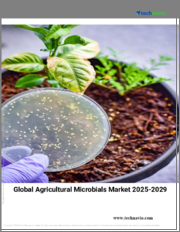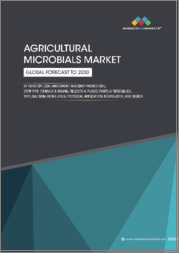
|
시장보고서
상품코드
1570911
농업용 미생물 시장 : 기회, 성장 촉진요인, 산업 동향 분석과 예측(2024-2032년)Agricultural Microbials Market, Opportunity, Growth Drivers, Industry Trend Analysis and Forecast, 2024-2032 |
||||||
세계의 농업용 미생물 시장은 2023년에 73억 4,080만 달러에 달하며, 2024-2032년 14.7%의 CAGR로 성장할 것으로 예측됩니다. 이러한 성장의 원동력은 지속가능한 농법에 대한 수요 증가와 작물 생산성 향상에 대한 필요성입니다. 박테리아, 곰팡이, 바이러스, 원생동물과 같은 미생물은 토양의 건강 상태를 개선하고 식물의 성장을 가속하며 해충과 질병으로부터 작물을 보호하는 데 사용됩니다. 주요 동향은 지속가능한 유기농법으로의 전환을 들 수 있습니다. 농가과 소비자들은 화학 농약과 화학 비료가 환경에 미치는 영향을 점점 더 많이 인식하고 있으며, 바이오 대체 농약에 대한 선호도가 높아지고 있습니다. 유럽과 북미와 같은 지역에서는 규제 조치가 이러한 변화를 촉진하고 있습니다.
박테리아 분야는 2023년 31억 30만 달러로 평가되었고, 2024-2032년 연평균 15.4%의 성장률을 보일 것으로 예상됩니다. 이 분야는 지속가능한 농업에 매우 중요하며, 질소 고정 박테리아는 합성 비료의 필요성을 줄이고, 인산 가용화 박테리아는 뿌리 발달을 촉진하며, 칼륨 고정 박테리아는 칼륨의 이용 가능성을 높입니다. 다른 유익한 박테리아도 전체 토양의 건강과 식물의 회복력에 기여합니다. 또한 미생물 연구의 발전으로 특정 토양 결함 및 작물의 요구에 맞는 맞춤형 박테리아 제제가 개발되어이 부문의 성장을 더욱 촉진하고 있습니다.
곡물 및 곡물 분야는 2023년 26억 1,090만 달러로 평가되며 2024-2032년 연평균 15.7%의 성장률을 보일 것으로 예상됩니다. 옥수수, 밀, 쌀, 보리와 같은 작물에 농업 미생물을 도입하는 것은 토양 건강과 작물 수확량을 향상시키는 지속가능한 관행의 필요성에 의해 추진되고 있습니다. 미생물은 영양분 흡수, 질병 저항성 및 작물의 회복력을 향상시켜 농가의 생산성과 수익성을 향상시킬 수 있습니다. 질소 고정 박테리아는 곡물 성장에 특히 중요하며, 바이오 자극제와 바이오 비료는 토양 고갈과 기후 변화에 대응합니다.
북미 농업용 미생물 시장은 2023년 25억 5,950만 달러 규모로 연평균 15.9% 성장할 것으로 예상됩니다. 이 지역의 성장 원동력은 첨단 농업 기술, 지속가능한 농업에 대한 집중, 유리한 규제입니다. 미국과 캐나다는 작물 수확량과 토양 품질을 향상시키는 미생물 솔루션의 채택을 주도하고 있습니다. 유기농 및 유전자 변형이 없는 농산물에 대한 수요가 증가함에 따라 농가는 기존 화학물질 대신 친환경 대안을 선택하고 있습니다. 식품 안전과 환경에 미치는 영향에 대한 소비자의 우려도 바이오 비료, 바이오 농약, 바이오 자극제의 사용을 촉진하고 있습니다.
목차
제1장 조사 방법과 조사 범위
제2장 개요
제3장 업계 인사이트
- 에코시스템 분석
- 주요 제조업체
- 유통업체
- 업계 전체의 이익률
- 업계에 대한 영향요인
- 촉진요인
- 시장이 해결해야 할 과제
- 시장 기회
- 새로운 기회
- 성장 가능성 분석
- 원재료 상황
- 제조 동향
- 기술의 진화
- 지속가능 제조
- 그린 프랙티스
- 탈탄소화
- 지속가능 제조
- 원재료의 지속가능성
- 가격 동향(달러/톤), 2021-2032년
- 규제와 시장에 대한 영향
- Porter의 산업 분석
- PESTEL 분석
제4장 경쟁 구도
- 기업 점유율 분석
- 경쟁 포지셔닝 매트릭스
- 전략 전망 매트릭스
제5장 시장 규모·예측 : 유형별, 2021-2032년
- 주요 동향
- 박테리아
- 질소 고정 세균
- 인산 가용화 세균
- 칼리 고정화 세균
- 기타
- 균류
- 균근균
- 트리코데르마
- 기타
- 바이러스
- 원충
제6장 시장 규모·예측 : 기능별, 2021-2032년
- 주요 동향
- 토양 개량
- 바이오 비료
- 바이오 비료
- 작물 보호제
- 바이오 살충제
- 바이오 살균제
- 바이오 살생물제
- 바이오 제초제
제7장 시장 규모·예측 : 제제별, 2021-2032년
- 주요 동향
- 건식 제제
- 과립제
- 분말
- 액체 제제
- 현탁액
- 유화제
- 기타
제8장 시장 규모·예측 : 2021-2032년, 용도 모드별
- 주요 동향
- 엽면살포
- 토양 치료
- 종자 치료
- 수확 후 농약 살포
제9장 시장 규모·예측 : 제제별, 2021-2032년
- 주요 동향
- 곡물·곡류
- 옥수수
- 밀
- 쌀
- 보리
- 기타
- 과일·채소
- 사과
- 베리류
- 감귤류
- 토마토
- 감자
- 기타
- 지방 종자와 두류
- 대두
- 카놀라
- 해바라기
- 기타
- 기타 작물
- 잔디·관엽식물
- 사료작물
- 기타
제10장 시장 규모·예측 : 지역별, 2021-2032년
- 주요 동향
- 북미
- 미국
- 캐나다
- 유럽
- 독일
- 영국
- 프랑스
- 이탈리아
- 스페인
- 기타 유럽
- 아시아태평양
- 중국
- 인도
- 일본
- 한국
- 호주
- 기타 아시아태평양
- 라틴아메리카
- 브라질
- 멕시코
- 아르헨티나
- 기타 라틴아메리카
- 중동 및 아프리카
- 사우디아라비아
- UAE
- 남아프리카공화국
- 기타 중동 및 아프리카
제11장 기업 개요
- Andermatt Group AG
- BASF SE
- Certis USA L.L.C
- FMC Corporation
- Koppert
- Novozymes A/S
- Sumitomo Chemical Co., Ltd
- Varsha Bioscience and Technology India Pvt Ltd.
- PI Industries Ltd
- Indian Farmers Fertilizer Cooperative Limited
The Global Agricultural Microbials Market reached USD 7,340.8 million in 2023 and is projected to grow at a CAGR of 14.7% from 2024 to 2032. This growth is driven by the rising demand for sustainable agricultural practices and the need to boost crop productivity. Microorganisms such as bacteria, fungi, viruses, and protozoa are used to improve soil health, promote plant growth, and protect crops from pests and diseases. Key trends include a shift towards sustainable and organic farming practices. Farmers and consumers are increasingly aware of the environmental impact of chemical pesticides and fertilizers, leading to a preference for bio-based alternatives. Regulatory measures in regions like Europe and North America support this shift.
The overall agricultural microbials industry is classified based on the type, function, formulation, mode of application, crop type, and region.
The bacteria segment was valued at USD 3,100.3 million in 2023 and is expected to grow at a CAGR of 15.4% from 2024 to 2032. This segment is crucial for sustainable farming, with nitrogen-fixing bacteria reducing the need for synthetic fertilizers, phosphate-solubilizing bacteria enhancing root development, and potash-mobilizing bacteria increasing potassium availability. Other beneficial bacteria contribute to overall soil health and plant resilience. Additionally, advancements in microbial research are leading to the development of tailored bacterial formulations that address specific soil deficiencies and crop needs, further driving the segment's growth.
The cereals and grains segment was valued at USD 2,610.9 million in 2023 and is projected to grow at a CAGR of 15.7% from 2024 to 2032. The adoption of agricultural microbials in crops like corn, wheat, rice, and barley is driven by the need for sustainable practices that improve soil health and crop yields. Microbial enhance nutrient uptake, disease resistance, and crop resilience, leading to increased productivity and profitability for farmers. Nitrogen-fixing bacteria are particularly important for cereal crop growth, while biostimulants and biofertilizers address soil depletion and climate variability.
North America's agricultural microbials market was valued at USD 2,559.5 million in 2023 and is expected to grow at a CAGR of 15.9%. The region's growth is driven by advanced agricultural techniques, a focus on sustainable farming, and favorable regulations. The U.S. and Canada are leading the adoption of microbial solutions to improve crop yields and soil quality. The demand for organic and non-GMO products is rising, and farmers are increasingly choosing eco-friendly alternatives to traditional chemicals. Consumer concerns about food safety and environmental impact are also boosting the use of biofertilizers, biopesticides, and biostimulants.
Table of Contents
Chapter 1 Methodology and Scope
- 1.1 Market scope and definition
- 1.2 Base estimates and calculations
- 1.3 Forecast calculation
- 1.4 Data sources
- 1.4.1 Primary
- 1.4.2 Secondary
- 1.4.2.1 Paid sources
- 1.4.2.2 Public sources
Chapter 2 Executive Summary
- 2.1 Industry 360° synopsis
Chapter 3 Industry Insights
- 3.1 Industry ecosystem analysis
- 3.1.1 Key manufacturers
- 3.1.2 Distributors
- 3.1.3 Profit margins across the industry
- 3.2 Industry impact forces
- 3.2.1 Growth drivers
- 3.2.2 Market challenges
- 3.2.3 Market opportunity
- 3.2.3.1 New opportunities
- 3.2.3.2 Growth potential analysis
- 3.3 Raw material landscape
- 3.3.1 Manufacturing trends
- 3.3.2 Technology evolution
- 3.3.2.1 Sustainable manufacturing
- 3.3.2.1.1 Green practices
- 3.3.2.1.2 Decarbonization
- 3.3.2.1 Sustainable manufacturing
- 3.3.3 Sustainability in raw materials
- 3.3.4 Pricing trends (USD/Ton), 2021 - 2032
- 3.3.4.1 North America
- 3.3.4.2 Europe
- 3.3.4.3 Asia Pacific
- 3.3.4.4 Latin America
- 3.3.4.5 Middle East and Africa
- 3.4 Regulations and market impact
- 3.5 Porter's analysis
- 3.6 PESTEL analysis
Chapter 4 Competitive Landscape, 2023
- 4.1 Company market share analysis
- 4.2 Competitive positioning matrix
- 4.3 Strategic outlook matrix
Chapter 5 Market Size and Forecast, By Type, 2021-2032 (USD Million, Tons)
- 5.1 Key trends
- 5.2 Bacteria
- 5.2.1 Nitrogen-fixing bacteria
- 5.2.2 Phosphate-solubilizing bacteria
- 5.2.3 Potash-mobilizing bacteria
- 5.2.4 Others
- 5.3 Fungi
- 5.3.1 Mycorrhizal fungi
- 5.3.2 Trichoderma
- 5.3.3 Others
- 5.4 Viruses
- 5.5 Protozoa
Chapter 6 Market Size and Forecast, By Function, 2021-2032 (USD Million, Tons)
- 6.1 Key trends
- 6.2 Soil amendments
- 6.2.1 Biofertilizers
- 6.2.2 Biostimulants
- 6.3 Crop protection
- 6.3.1 Bioinsecticides
- 6.3.2 Biofungicides
- 6.3.3 Bionematicides
- 6.3.4 Bioherbicides
Chapter 7 Market Size and Forecast, By Formulation, 2021-2032 (USD Million, Tons)
- 7.1 Key trends
- 7.2 Dry formulation
- 7.2.1 Granules
- 7.2.2 Powder
- 7.3 Liquid formulation
- 7.3.1 Suspension concentrates
- 7.3.2 Emulsifiable concentrates
- 7.3.3 Others
Chapter 8 Market Size and Forecast, By Mode of Application, 2021-2032 (USD Million, Tons)
- 8.1 Key trends
- 8.2 Foliar spray
- 8.3 Soil treatment
- 8.4 Seed treatment
- 8.5 Post-harvest
Chapter 9 Market Size and Forecast, By Formulation, 2021-2032 (USD Million, Tons)
- 9.1 Key trends
- 9.2 Cereals and Grains
- 9.2.1 Corn
- 9.2.2 Wheat
- 9.2.3 Rice
- 9.2.4 Barley
- 9.2.5 Others
- 9.3 Fruits and Vegetables
- 9.3.1 Apples
- 9.3.2 Berries
- 9.3.3 Citrus fruits
- 9.3.4 Tomatoes
- 9.3.5 Potatoes
- 9.3.6 Others
- 9.4 Oilseeds and Pulses
- 9.4.1 Soybean
- 9.4.2 Canola
- 9.4.3 Sunflower
- 9.4.4 Others
- 9.5 Other Crops
- 9.5.1 Turf and Ornamentals
- 9.5.2 Forage crops
- 9.5.3 Others
Chapter 10 Market Size and Forecast, By Region, 2021-2032 (USD Million, Tons)
- 10.1 Key trends
- 10.2 North America
- 10.2.1 U.S.
- 10.2.2 Canada
- 10.3 Europe
- 10.3.1 Germany
- 10.3.2 UK
- 10.3.3 France
- 10.3.4 Italy
- 10.3.5 Spain
- 10.3.6 Rest of Europe
- 10.4 Asia Pacific
- 10.4.1 China
- 10.4.2 India
- 10.4.3 Japan
- 10.4.4 South Korea
- 10.4.5 Australia
- 10.4.6 Rest of Asia Pacific
- 10.5 Latin America
- 10.5.1 Brazil
- 10.5.2 Mexico
- 10.5.3 Argentina
- 10.5.4 Rest of Latin America
- 10.6 MEA
- 10.6.1 Saudi Arabia
- 10.6.2 UAE
- 10.6.3 South Africa
- 10.6.4 Rest of MEA
Chapter 11 Company Profiles
- 11.1 Andermatt Group AG
- 11.2 BASF SE
- 11.3 Certis USA L.L.C
- 11.4 FMC Corporation
- 11.5 Koppert
- 11.6 Novozymes A/S
- 11.7 Sumitomo Chemical Co., Ltd
- 11.8 Varsha Bioscience and Technology India Pvt Ltd.
- 11.9 PI Industries Ltd
- 11.10 Indian Farmers Fertilizer Cooperative Limited



















